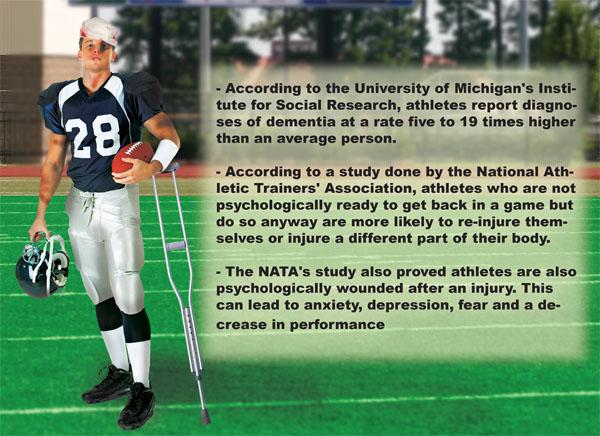Danger in the drive of competition

Danger in the drive of competition
October 19, 2009
Athletes hold a distinctive place in our society. We praise them as our warriors, championing for greatness on the field of battle. Revered for their strength and grit, we admire their persistence in the face of adversity. Through their ability to struggle, endure and overcome challenges both mental and physical, they inspire us to test the bounds of our own limitations.
Motivated by the thrill of victory and the fear of the agony of defeat, athletes spend countless hours, days, weeks, months and years training to extend their capabilities. Spurred by the notion that their competition is pushing even harder, they adhere to strict guidelines, diets and workout regimens looking to gain or preserve any advantage over their competition.
In fact, in a recent study done by the University of Michigan’s Institute for Social Research and originally reported by The New York Times on Sept. 29, former NFL players were found to be five to 19 times more likely than the national population to have been diagnosed with Alzheimer’s disease or other memory-related injuries.
While it might seem that this is an issue only for professional athletes who make a living out of putting their bodies into harm’s way, it has been happening more and more frequently in the worlds of college and high school athletics.
In fact, special measures have been instituted in universities throughout the country to protect athletes when it comes to injury, especially concussions.
Heather Farwig, assistant athletic trainer, said Sacramento State retailored its protocol again this year for assessing concussions and preventing players from coming back too soon.
“We’ve grown a lot more conservative, especially when dealing with concussions,” she said. “Athletes are restricted from all activity for a minimum of three days and can only gradually work back in when all symptoms have cleared.”
At Sac State, athletes are even given a specially designed online test called the ImPACT Test to help assess the severity of concussions and the recovery process in other injuries.
At the beginning of the season, when completely healthy, an athlete is administered the online exam which tests his or her capacity for shape memory, word memory and reaction time, along with a 20-question symptom survey. During the season, if a player is suspected of having a concussion, they are re-administered the test and the scores are compared to the original.
The test has proven highly effective, as it is unique to each individual as opposed to being standardized and leaves little room for cheating. Enduring pain is a prerequisite in athletics. Used as an adrenaline rush, pain can even become part of the appeal. Athletes learn to feed off it, sometimes going so far as to grow addicted to it.
Hornets free safety Deionte Gordon, who sprained both his ACL and MCL in a game against Cal Poly, San Luis Obispo, said that the process for getting back on the field after serious injury has become more thorough.
“I spent a lot of time in the training room where our trainers did a great job of rehabbing me,” he said. “After that, I had to get cleared by the team doctor. If he doesn’t clear you, you can’t play. Once he cleared me, it became my decision to play or not.”
Even with the possibility that he could have torn his ACL or MCL, Gordon has played in all three of the Hornets’ games since the injury occurred on Sept. 12.
This does not even take into account the psychological damage that can come from returning to a sport too early.
According to a study done by the National Athletic Trainers’ Association, athletes who are not psychologically ready to get back in a game but do so anyway for fear of being cut, can lead to re-injury or they can even get an injury to a different body part. They are so worried about protecting their injured body part that they forget to protect the rest of their body.
The study also found athletes are susceptible to depression and decreased performance.
Stamati Horiates can be reached at [email protected]












































































































































